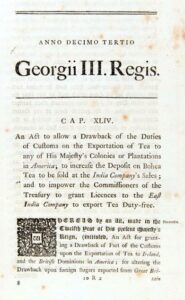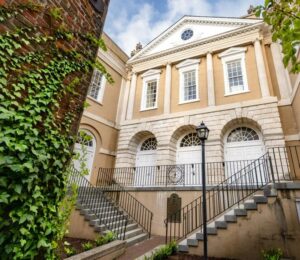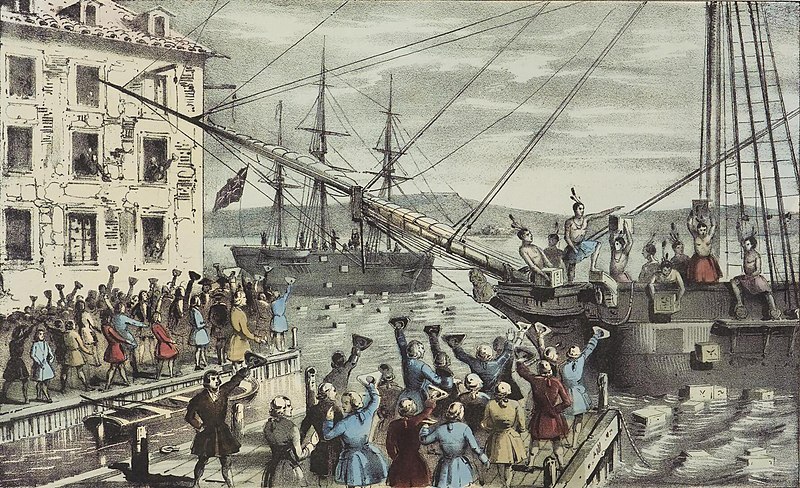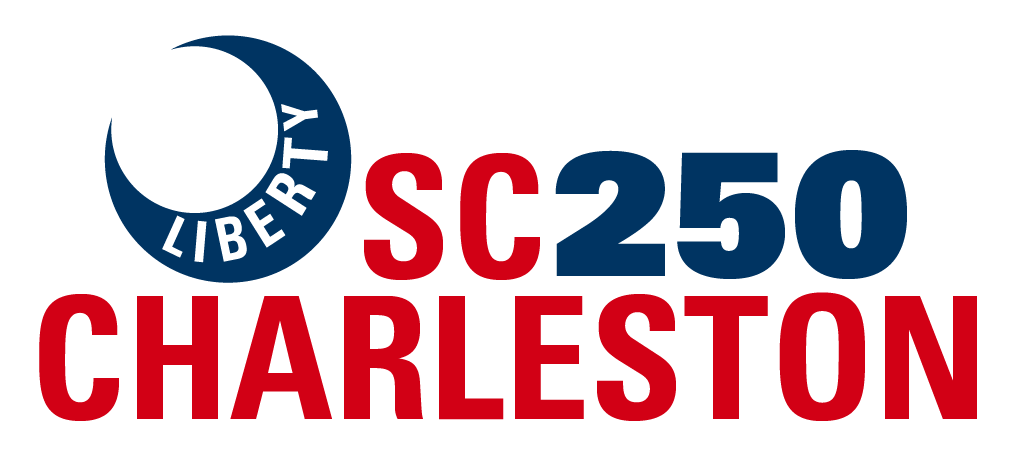On December 3, 1773, Charlestonians rose in anger against Parliament and the arrival of the ship London carrying East India Company tea. Their resistance to the Tea Act of 1773 – Parliament’s internal tax on the colonists- happened thirteen days before the more famous Boston Tea Party. This and other interesting Charleston Tea Protest facts can be found below.
-
The Tea Act of 1773, which created a furor in Charleston, actually lowered the price of tea.

Most taxes are resented by the affected population since they tend to increase the price of a commodity. Parliament’s Tea Act of 1773, which, despite its three-penny per pound tax, effectively lowered the price of British tea for American colonists. The Tea Act achieved this reduction by eliminating the duty on tea and the mandatory tea auctions in England, which tended to push the global price of tea higher. Now free to export their tea directly to America, it was anticipated that local East India Company (EIC) – selected merchants would set far more competitive prices in their local American markets. In fact, under the Tea Act of 1773, British East India Company tea would become not only far cheaper in America than the same tea purchased by those in the British Isles but also less expensive than the smuggled tea Americans drank in prodigious quantities. All of this was of great importance to Parliament, given that EIC warehouses were stuffed with unsold tea – almost 20 million pounds of it – and the company was facing bankruptcy.
-
South Carolina patriots decried that the Tea Act of 1773 was an “internal” tax placed on them by a Parliament that did not represent them.
If the Tea Act of 1773 lowered the price of tea for Americans, why then were the colonists so upset over this act by Parliament? The primary reason was that the Tea Act of 1773 was widely viewed as just the latest in a series of “internal” taxes placed directly on American colonists by a revenue-hungry Parliament that did not include American-elected representatives. No taxation without representation! The anonymous author, Junius Brutus, in the South Carolina Gazette on November 22, 1773, declared that
“a Tax of the value of one penny levied upon us without our consent, as effectually takes away our liberty, as if the sum were a million.”
-
The proper serving of tea was a means of displaying one’s wealth and a popular social activity amongst the elite in 18th-century Charlestown.

Tea was one of the most popular beverages in Charleston in the 1770s. Wealthy Charlestonians cherished the social interactions of their afternoon teas, and all the expensive items associated with the proper serving of tea were another means of displaying one’s wealth and status. Fancy imported tea tables, tea chests filled with the finest teas, teapots, silver decanters, porcelain cups and saucers, bowls filled with expensive sugar, tongs, and so much more were all a part of the overall presentation around tea. So, the giving up of tea was, for many in the city, a serious sacrifice, but one that many willingly made in the name of liberty. One amusing poem published in papers up and down the Atlantic seaboard was entitled “A Lady’s Adieu to Her Tea-Table.” One version of that published poem has a lady saying farewell to “the Tea-board with your gaudy attire, ye cups and ye saucers that I did admire..” [Video] The poem goes on to state that the author would rather fill her fancy cups with water before drinking the “detestable stuff we can quit when we please.”
-
The British ship London arrived in Charleston harbor on December 2, 1773, carrying 257 chests of East India tea.
After the passing of the Tea Act of 1773, the East India Company loaded tea from their warehouses onto seven different merchant ships that were all to sail to different ports in America at roughly the same time. Four were dispatched to Boston, and one each was sent to New York City, Philadelphia, and Charleston. The first ship to arrive was the Dartmouth in Boston on November 28, 1773. The second to arrive was the merchant ship London, which tied up to a busy Charleston wharf on December 2, 1773. Aboard the London were 257 heavy chests of tea – mostly bohea variety – almost 70,000 pounds of EIC tea ready to be unloaded, taxed, and sold.

-
Rising in support of an embargo on British tea, so many Charlestonians crowded into the Exchange building on December 3, 1773, that the beams of the building bowed.

The arrival of the tea-carrying London at Charleston’s waterfront created an immediate stir in the city. Already warned of the pending arrival of the London, agitated Charlestonians packed into the Great Hall over the Exchange building on December 3, 1773, to formulate a plan. So many Charlestonians from a variety of social classes crammed into the elegant room, that the beams and floorboard began to creak and groan. Many of the more angry and powerful Charlestonians, led by Christopher Gadsden, confronted Charleston merchants whom the EIC designated to receive the tea. Roger Smith, Peter Leger, and William Greenwood were all pressured not to accept the tea aboard the London. The merchants collectively declared to the audience that “they were willing to do any Thing…. To preserve the Peace and Quiet of the Community.” Captain Alexander Curling of the London was there too, and sensing a true crisis, declared that he would defuse the situation by “keeping all the tea on board his vessel and returning to England.”
More importantly, the gathered group established a General Committee of leading Charlestonians – Charles Pinckney, Charles Cotesworth Pinckney, Thomas Ferguson, Christopher Gadsden, and Daniel Cannon – who authored a non-importation agreement for the colony. Many in attendance came forward to sign the document and defy Parliament and its taxes.
“We the underwritten, do hereby agree, not to import, either directly or indirectly, any teas that will pay the present duty, laid by an act of the British Parliament for the purpose of raising revenue in America.”
-
Charleston’s resistance to the landing of tea happened a full thirteen days before the more famous Boston Tea Party.
The seven East India Company merchant ships departed Britain at roughly the same time in late 1773, but due to the vagaries of sea travel across the Atlantic, the ships arrived in America at different times. The London, the second of the EIC ships to arrive, reached Charleston on December 2, 1773. Charlestonians, the very next day, confronted the ship, its captain, and the local merchants who were to receive the tea. This act of defiance and the non-important agreement authored on the 3rd happened a full thirteen days before Bostonians more famously dumped the EIC’s tea into Boston Harbor on December 16, 1773. In these days before telegraphs and railroads, news traveled slowly up and down the American seaboard. As such, on December 3, 1773, Charlestonians had no knowledge of what other American cities were facing or doing to oppose the arrival of this tea. In fact, Charlestonians wouldn’t learn of the more famous “Boston Tea Party” until later in January of 1774.
While the actions of Boston’s “Mohawks” were widely considered the most aggressive of all the cities’ reactions, Charleston’s resistance to the arrival of the EIC was also noted by South Carolina’s Lieutenant Governor William Bull in a February 5, 1774, letter to Lord Dartmouth. While “not equal in criminality to the Proceedings in other colonies…. But was still a “most unwarrantable Insult to the authority of the Kingdom.”

-
Despite threats of violence, Charleston customs agents had the tea from the London taken to the Exchange building and stored in its basement until it was seized and sold by Charlestonian patriots to support the Revolution.
After the tense standoff of December 3, 1773, the London remained alongside its Charleston wharf with its tea still onboard. While many patriots believed that the tea would soon return from whence it came, other royal officials in Charleston worked on a different plan. Per the laws of the time, merchant ships needed to pay customs on their cargo. Failure to do so within 20 days of their arrival would lead to a seizure of the cargo for non-payment of the Royal duties. With that date very much in mind, South Carolina’s Lieutenant Governor William Bull worked with Robert Haliday, the recently arrived customs official for Charleston, John Morris, Charleston’s Comptroller of Customs, and Captain Curling of the London on a plan to move the chests of tea off the ship and into the basement of the nearby Exchange building. Early on the morning of December 22, 1773, hired laborers, under the employ of royal officials, hauled all 257 of the tea chests off the ship and into the Exchange with no interference – an amazing physical feat that even impressed those opposed to the landing of the tea. Upset that the tea had made its way off the ship, the anti-tea Committee passed a resolution on January 20, 1774, that stated that “the East India Company’s TEA now lying in a cellar under the Exchange, shall not be SOLD in this province, which subject to such duty; and, that we will by every means in our power, prevent such sale or removal.”
Safe within the Exchange’s basement, the tea remained in its chests, until it was seized almost three years later by patriotic Charlestonians who then sold the tea in September of 1776 to support America’s war for independence. How drinkable this three-year-old tea was in 1776 was not reported.

-
In response to the tea crisis, Charleston’s merchants formed the city’s Chamber of Commerce. Which is the oldest city-based chamber of commerce in the United States.
While many Charlestonians opposed the East India Company’s tea and Parliament’s new tax on this popular commodity, many of Charleston’s merchants were not too sure about supporting the policy of non-importation. Looking to better coordinate their actions during the crisis, a group of prominent merchants met on December 9, 1773, at Mrs. Swallow’s Tavern on Broad Street and formed the Charleston Chamber of Commerce. Their stated mission was to “extend Commerce, encourage Industry, and adjust Disputes relative to Trade and Navigation.” Still operating today, Charleston’s Metro Chamber of Commerce is the oldest city-commercial organization in the United States and the second-oldest commercial organization of any kind in the Nation.
-
In addition to Charleston’s first tea crisis in 1773, there were at least two other major tea confrontations that occurred in Charleston in 1774.
In addition to the tea crisis of December 1773, there were at least two other major confrontations between Charlestonians and newly arrived merchant ships carrying EIC tea. The South Carolina Gazette reported that on June 26, 1774, the merchant ship Magna Charta had arrived in Charleston and that the ship was carrying “two chests and a half of tea.” The Charleston Committee angrily confronted Captain Richard Maitland of the Magna Charta, who declared that he did not learn of the tea being on his ship until after he departed and that he would leave the tea onboard. But like with the London, this smaller shipment of tea also made its way to the underground cellar of the Exchange. Once the Charleston Committee learned this, they angrily confronted the captain and prevented the tea from reaching any merchants in the city. Others, incensed that a second shipment of tea had made landfall in the city, searched the town for Captain Maitland, with the intent of doing harm to the man. Maitland, aware of his growing danger, secreted aboard another ship in the harbor and later found his way back to the Magna Charta and made a hasty retreat to sea.
A third ship, the Britannia, carrying seven chests of EIC tea tied up at a Charleston wharf on November 1, 1774. This time, Charlestonians took no chances with this shipment. Captain Ball of the Britannia was called in front of the Committee the next day and admitted that seven chests of the “mischievous drug” were onboard his ship. On November 3, 1774, Captain Ball and the three merchants designated to receive the tea were rowed out to the Britannia and then forced to dump the tea into Charleston Harbor. As reported in the South Carolina Gazette, “at noon, an oblation was made to NEPTUNE, of the said seven chests of tea.” A huge crowd of Charlestonians, who had gathered for this confrontation, gave three hearty cheers as the tea reached the waters of the harbor. For now, Charleston would have its own tea party.
-
Resistance against the Tea Act of 1773 led to the rise of an independent government in South Carolina.
The five-person committee elected on December 3, 1773, in response to the Charleston tea crisis, quickly developed into a much larger and more representative body. In July of 1774, the Committee membership was expanded to 99, which was to include 15 merchants, 15 mechanics, and 69 planters. Designed to give this new, independent representative body more legitimacy, elections were to be held throughout South Carolina. Once formed on January 11, 1775, and named the First Provincial Congress, South Carolina now had an independent government that included representatives from the backcountry as well. As the united colonies moved towards armed rebellion and then outright independence, South Carolina’s Provincial Congress provided the colony with a legitimate civilian government it needed at this time of crisis. It was this body, initially formed to resist the arrival of taxed tea, that would create South Carolina’s first state constitution on March 26, 1776, and would direct the colony’s resistance to the British when their warships and troops arrived off the port on June 26, 1776.
